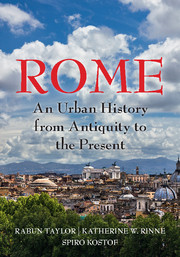Book contents
- Frontmatter
- Dedication
- Epigraph
- Contents
- List of Illustrations
- Acknowledgments
- Map
- INTRODUCTION
- 1 A BEND IN THE RIVER
- 2 A STORYBOOK BEGINNING
- 3 IDEOLOGICAL CROSSFIRE
- 4 BIG MEN ON THE CAMPUS
- 5 RES PUBLICA RESTITUTA
- 6 MEMORIALS IN MOTION: SPECTACLE IN THE CITY
- 7 THE CONCRETE STYLE
- 8 REMAKING ROME'S PUBLIC CORE: I
- 9 REMAKING ROME'S PUBLIC CORE: II
- 10 CRISIS AND CONTINUITY
- 11 RUS IN URBE: A GARDEN CITY
- 12 ADMINISTRATION, INFRASTRUCTURE, AND DISPOSAL OF THE DEAD
- 13 MAPPING, ZONING, AND SEQUESTRATION
- 14 TETRARCHIC AND CONSTANTINIAN ROME
- 15 TROPHIES AND TITULI: CHRISTIAN INFRASTRUCTURE BEFORE CONSTANTINE
- 16 WALLS MAKE CHRISTIANS: FROM FOURTH TO FIFTH CENTURY
- 17 A TALE OF TWO ROMES
- 18 THE ROME OF GOTHS AND BYZANTINES
- 19 CHRISTIAN FOUNDATIONS
- 20 FROM DOMUS LATERANI TO ROMANUM PALATIUM
- 21 THE LEONINE CITY: ST. PETER'S AND THE BORGO
- 22 VIA PAPALIS, THE CHRISTIAN DECUMANUS
- 23 THE URBAN THEATERS OF IMPERIUM AND SPQR
- 24 HOUSING DAILY LIFE
- 25 CHAOS IN THE FORTIFIED CITY
- 26 THE TIBER RIVER
- 27 HUMANIST ROME, ABSOLUTIST ROME (1420–1527)
- 28 PLANNING COUNTER REFORMATION ROME
- 29 PROCESSIONS AND POPULATIONS
- 30 MAGNIFICENT PALACES AND RHETORICAL CHURCHES
- 31 NEOCLASSICAL ROME
- 32 PICTURING ROME
- 33 REVOLUTION AND RISORGIMENTO
- 34 ITALIAN NATIONALISM AND ROMANITÀ
- 35 A CITY TURNED INSIDE OUT
- Glossary of Persons, Places, and Terms
- Works Cited
- Index
15 - TROPHIES AND TITULI: CHRISTIAN INFRASTRUCTURE BEFORE CONSTANTINE
Published online by Cambridge University Press: 05 July 2016
- Frontmatter
- Dedication
- Epigraph
- Contents
- List of Illustrations
- Acknowledgments
- Map
- INTRODUCTION
- 1 A BEND IN THE RIVER
- 2 A STORYBOOK BEGINNING
- 3 IDEOLOGICAL CROSSFIRE
- 4 BIG MEN ON THE CAMPUS
- 5 RES PUBLICA RESTITUTA
- 6 MEMORIALS IN MOTION: SPECTACLE IN THE CITY
- 7 THE CONCRETE STYLE
- 8 REMAKING ROME'S PUBLIC CORE: I
- 9 REMAKING ROME'S PUBLIC CORE: II
- 10 CRISIS AND CONTINUITY
- 11 RUS IN URBE: A GARDEN CITY
- 12 ADMINISTRATION, INFRASTRUCTURE, AND DISPOSAL OF THE DEAD
- 13 MAPPING, ZONING, AND SEQUESTRATION
- 14 TETRARCHIC AND CONSTANTINIAN ROME
- 15 TROPHIES AND TITULI: CHRISTIAN INFRASTRUCTURE BEFORE CONSTANTINE
- 16 WALLS MAKE CHRISTIANS: FROM FOURTH TO FIFTH CENTURY
- 17 A TALE OF TWO ROMES
- 18 THE ROME OF GOTHS AND BYZANTINES
- 19 CHRISTIAN FOUNDATIONS
- 20 FROM DOMUS LATERANI TO ROMANUM PALATIUM
- 21 THE LEONINE CITY: ST. PETER'S AND THE BORGO
- 22 VIA PAPALIS, THE CHRISTIAN DECUMANUS
- 23 THE URBAN THEATERS OF IMPERIUM AND SPQR
- 24 HOUSING DAILY LIFE
- 25 CHAOS IN THE FORTIFIED CITY
- 26 THE TIBER RIVER
- 27 HUMANIST ROME, ABSOLUTIST ROME (1420–1527)
- 28 PLANNING COUNTER REFORMATION ROME
- 29 PROCESSIONS AND POPULATIONS
- 30 MAGNIFICENT PALACES AND RHETORICAL CHURCHES
- 31 NEOCLASSICAL ROME
- 32 PICTURING ROME
- 33 REVOLUTION AND RISORGIMENTO
- 34 ITALIAN NATIONALISM AND ROMANITÀ
- 35 A CITY TURNED INSIDE OUT
- Glossary of Persons, Places, and Terms
- Works Cited
- Index
Summary
BEFORE CONSTANTINE ARRIVED IN ROME, THE WORSHIP OF CHRIST HAD already found some favor among the Roman elite. There may also have been a loose confederation of small domus ecclesiae (“houses of the church,” or house-churches) within the city and extramural cemeteries sponsored by prosperous Christians. But a cohesive Christian institution with an administrative infrastructure – what we call the Church, with a capital C – may only have developed after Constantine. In fact, Rome's domus ecclesiae, extrapolated from later literary sources, have eluded archaeological corroboration. Yet they must have existed, even if their importance, especially among elite worshippers, has been exaggerated. Shops and other venues suited to lower-status Romans, who constituted the great majority of Rome's Christians, would also have hosted informal congregations. Above- and belowground cemeteries proliferated outside the Aurelian Wall and “trophies,” memoriae, were set over the newly built tombs of notable martyrs in them; these became sites for ritual enactment and important processional destinations. Burial places, known as areae, were dispersed along major consular roads. Some were extensive underground catacombs; others held freestanding sarcophagi, mausolea, or rows of simple graves presumably topped by movable funeral tables (mensae).
Over time the Church, needing to confer administrative uniformity on the observances of the faith and a clear environmental order among the separate loci, took issue with these extemporaneous and diffuse practices. Although it may eventually have acquired sites already marked by Christian use through bequests or purchase, this does not imply a physical master plan for Rome at this time. Rather, as more private property passed to the church, its authority over rituals, burials, and the spaces accommodating them gradually centralized so that, for example, specific churches became allied with specific cemeteries, often establishing physical proximity and sharing officiating clergy with them.
A list generated at the synod (church council) of 499 mentions 25 administrative parish churches in Rome. Known as tituli, from the Latin meaning “legal title” or simply “inscription,” each reputedly had its own clergy and cardinal. It was long believed that some tituli were pre-Constantinian, their primordial remains underlying the later basilicas; but as with the claim for domus ecclesiae, archaeological confirmation eludes us and literary testimony is untrustworthy. Many of these churches may have developed independently and haphazardly, acquiring their “titles” only later, when an ecclesiastical infrastructure had developed to systematize them.
- Type
- Chapter
- Information
- RomeAn Urban History from Antiquity to the Present, pp. 142 - 150Publisher: Cambridge University PressPrint publication year: 2016



